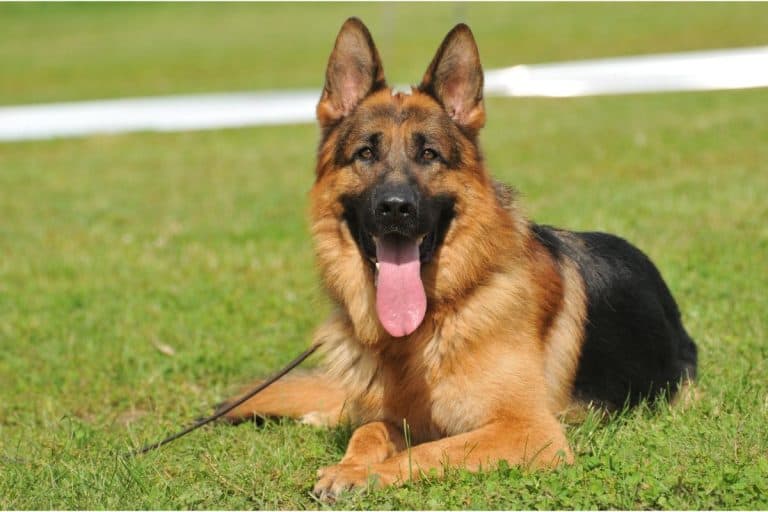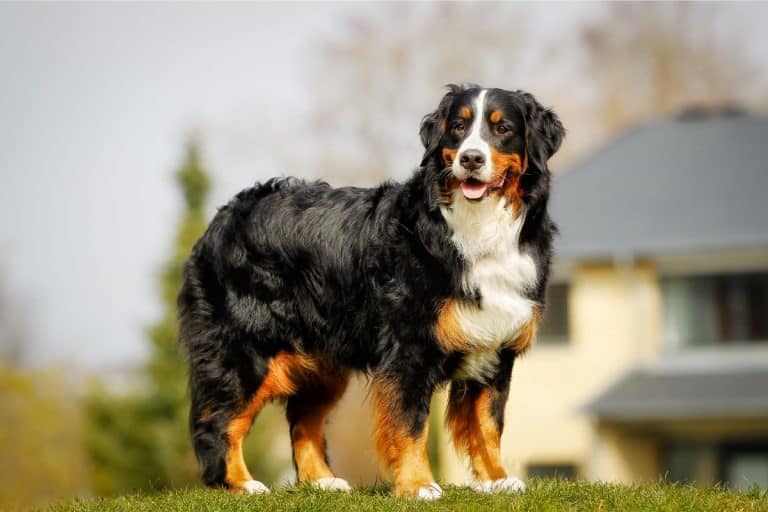Saint Berdoodle Growth Chart
Who doesn’t love Saint Berdoodles?
Even though they might not be one of the most popular or well-known breeds of dog in the world, Saint Berdoodles are adorable dogs that are known for their kind temperament and unwavering loyalty.
So much so, that they are quickly building a reputation for being great family dogs.
Still, one of the most common questions that many people find themselves asking when they are considering purchasing a Saint Berdoodle is how big they get – especially given the fact that the adult size of a Saint Berdoodle can often vary between medium to large… and sometimes even giant!
In this guide today, we are going to be answering that question, as well as provide you with some additional information about Saint Berdoodles so that you can make the most informed decision about whether or not a Saint Berdoodle is going to be the right, furry addition to your family for you.
So, without further ado, let’s jump right in!
What Is A Saint Berdoodle?
- Breed Type: Hybrid: Poodle/Saint Bernard
- Average Weight: 115-210lbs
- Average Size: 30inches+
- Characteristics: Affectionate, Kind, Gentle, Loyal
Before we jump any further into this article, we first think that it would be a good idea to explain to you what a Saint Berdoodle is.
This will help you to gain a better understanding of whether or not this particular breed of dog is going to be the best choice for you, your family, and your home.
Sure, big dogs can sometimes have a reputation for being great guard dogs and sometimes even scary, Saint Berdoodles are loveable and friendly giants that you can’t help but adore.
Despite their larger size, Saint Berdoodles are known for being extremely kind dogs that love nothing more than to be affectionate and gentle towards their owners and family.
With that being said, it should come as no surprise to hear that these dogs are also known for having a reputation for loving cuddles, too!
As we have already briefly discussed above, despite the fact that these dogs are one of the lesser-known breeds of dogs, they are slowly becoming popular family dogs simply because of their kind temperaments, loyal nature, and reputation for being great with children.
As you might have already guessed, they are a hybrid between the two well-known breeds: Poodle and Saint Bernard, which means that they are a hybrid breed of dog.
Due to this hybrid mix of these two breeds of dog, besides being known for being a cuddly and friendly breed of dog, you might also be interested to learn that Saint Bernards are sometimes considered to be a hypoallergenic breed of dog, which means that they are also a great option for those who suffer from allergies and are unable to own dogs that trigger their allergies.
However, keep in mind that whether or not a Saint Berdoodle is hypoallergenic is heavily influenced by whether they have inherited the minimal shedding fur coat by its poodle parent, as opposed to its Saint Bernard parent.
What Does The Saint Berdoodle Look Like?
So, now that you have a better idea of how large a Saint Berdoodle can get, you might now be interested in learning more about this adorable breed!
If you’re not overly familiar with this type of dog, you might be interested to learn a little more about what the appearance of this interesting breed of dog is.
Well, generally, a Saint Bernoodle is characterized by either a curly or smooth coat (depending on genes) and will often take on the facial features of the Saint Bernard parent except for the “sagging” eyes that are so commonly associated with that breed.
Rather, many owners of Saint Berdoodles often liken them to being big, cuddly teddy bears!
Still, despite the fact that Saint Bernards are known for being such cuddly and friendly dogs, they don’t get their reputation for being “friendly giants’ ‘ for nothing!
As we have already briefly touched upon above, Saint Bernards are no small breed of dog. In fact, they are one of the few breeds of dog that can reach anywhere from large to giant, depending on a variety of factors.
So much so that you might be pretty surprised to learn that Saint Berdoodles can reach sizes that rival some of the biggest breeds of dog in the world currently, such as the Bernese Mountain Dog.
This brings us to our next point!
How Big Does The Saint Berdoodle Get?

As we’re sure you’re already well aware by now, Saint Berdoodles are a hybrid breed of dog, which means that their appearance and size can often vary depending on DNA.
However, for the most part, if you are planning on adding an adorable Saint Berdoodle to your home, you can expect them to be large in size and, in some very rare cases, giant.
With that in mind, a Saint Berdoodle will usually reach around 30 inches in length, but this can sometimes even be larger than this amount.
In addition to this, in some instances a Saint Berdoodle might also sometimes reach a lower height of around 15 inches, but this is not overly common.
As for their weight? On average, a Poodle female adult will usually weigh around 40lbs, while a Poodle male adult will typically weigh a little more, at around 50lbs.
In addition to this, a Saint Bernard will usually weigh around 180lbs once it reaches full maturity and becomes an adult, and as Saint Berdoodles tend to be on the larger end of the height and size scale, it means that you can also expect a full-grown, adult Saint Berdoodle to weigh well over 100lbs.
However, while this might very well be the case, keep in mind that the size and weight of a Saint Bernoodle will usually be unique to each individual dog simply due to the fact that the Saint Berdoodle is a hybrid between a Poodle, which is a medium-sized dog, and a Saint Bernard, which is a large to giant sized dog.
Still, the standard Saint Berdoodle will usually be pretty large in size and weigh anywhere from 150 to 180lbs.
Fun Fact: Despite the fact that Saint Berdoodles are considered to be a very large breed of dog, you might be interested to learn that there have been some attempts to create a miniature version of the breed.
In order to achieve this size variation, a smaller dog such as a Cocker Spaniel is usually used to create the smaller, miniature size.
However, this is not very common, and the most common size associated with the Saint Berdoodle continues to be anywhere from medium all the way up to giant, with the most common size being large.
How Big Are Saint Berdoodles At Birth?
So, even though we all now know that Saint Berdoodles can grow pretty large in size once they reach adulthood, how big are they when they are first born?
Well, just like with most other breeds of dog that range in breed size, Saint Berdoodles aren’t usually that big when they are first born.
In fact, they are usually pretty small and will typically only weigh 1lbs, which is very little, especially when you consider how they can often grow to weigh upwards of 100lbs once they reach full adulthood.
Still, despite the fact that Saint Berdoodles often start off little, we’re sure that it will come as no surprise to learn that Saint Berdoodles are known for growing at an extremely fast rate once they have been born.
So, in other words, they don’t stay little for very long! In fact, after they have been born, you can expect Saint Berdoodles to have grown double their size in just one week. Yes, you read that right!
By around the first month, a Saint Berdoodle puppy will typically grow to around 6-8lbs, and will continue to grow and develop alongside their mom until around 3 months, at which point they will typically weigh anywhere between 15-20lbs, and will be ready to go off on their own with a new family.
Even though they grow pretty fast, it will typically take Saint Berdoodles around 3 years to reach their full, adult size. This brings us to our next section.
Saint Berdoodle Growth Chart
To help you gain a better understanding of how big a Saint Berdoodle can get, here is a helpful chart that you can use for reference:
| Age | Weight |
| 3 months | 25-30lbs |
| 4 months | 35-45lbs |
| 5 months | 50-55lbs |
| 6 months | 60-65lbs |
| 7 months | 70-75lbs |
| 8 months | 80-85lbs |
| 9 months | 90-95lbs |
| 10 months | 100-110lbs |
| 1 year | 110-118lbs |
| 2 years | 110-130lbs |
| 3 years | 130-180lbs |
Keep in mind that the above growth chart should only be used as a general guideline for how big a Saint Bernoodle will typically grow to, as well as at what rate.
As we have already mentioned at previous points throughout this guide, Saint Berdoodles are a hybrid breed, which means that there is a much higher chance of height and weight variations.
This means that the growth rate and weight of a Saint Berdoodle will often be unique to each dog, greatly depending on genes and DNA.
Despite this possible variation, it is also worth mentioning that a Saint Berdoodle will never be smaller than an adult-sized poodle. So, at the very least, these dogs will be at least medium-sized.
Saint Berdoodle Health Risks
So, now that you have discovered that Saint Berdoodles typically grow to be very large in size if you are interested in adding one to your family – it is important to keep in mind that their larger sizes can sometimes bring about a variety of health risks that you should be aware of prior to making your choice.
Even though the Saint Berdoodle is at risk of developing a variety of health risks associated with its size, by making sure that you are taking your Saint Berdoodle for regular check-ups throughout the year at the vet’s, any potential onset health issues should be picked up pretty early.
Along with that, you should also keep in mind that there are a variety of care duties that you can perform as the owner to ensure that your Saint Berdoodle is kept in tip-top, healthy condition.
Let’s take a look at some of the most important ones, and how they relate to their size below:
Living Conditions
First things first, if you are planning on getting a Saint Berdoodle, then it’s going to be very important that you make sure that the living environment that you give them is going to be suitable for their size.
As we have already discussed throughout this article, Saint Berdoodles can range from large to giant, which means that they are going to need to have plenty of space to be able to live comfortably in your home without feeling restricted.
In addition to a spacious living environment, you should also note that St Berdoodles require lots of space to run around and play, which means that they will require a big backyard or a nearby dog-friendly park or field to run around in.
For this reason, it should come as no surprise to hear that Saint Berdoodles are not suited to living in small apartments.
Energy Levels

High energy levels paired with a larger size means one thing: your Saint Berdoodle is going to need to have plenty of space to run around each day!
Along with making sure that you are taking your Saint Berdoodle on regular walks, you should also be sure that you are providing your Saint Berdoodle with plenty of space to run around and play, such as in your backyard.
Alternatively, if you do not have a big backyard, then you should research some local dog-friendly parks in your area so that you can let your Saint Berdoodle run around and burn off some energy.
Supporting Joint Health
Another care task that you can implement into your Saint Berdoodle diet to support its healthy lifestyle is to make sure that you are giving your Saint Berdoodle a variety of natural and dog-appropriate supplements that will be able to aid in your Saint Berdoodles healthy overall functioning, as well as to help strengthen and support your dog’s limbs, which are longer than the average dogs.
Many Saint Berdoodle dog owners will usually incorporate safe and natural supplements that will be able to support overall joint health such as omega fatty acids and glucosamine, although if you are interested in doing this, we strongly recommend that you consult with your veterinarian beforehand to make sure that you are giving your dog the appropriate supplements.
Who knows, your dog’s vet might even recommend some additional supplements that will be breed-specific and tailored to supporting your Saint Berdoodle all throughout its life.
Saint Berdoodle Grooming Needs
Along with considering the potential health risks associated with a breed of dog of this size, it is also just as important to consider what the grooming needs are going to be if you do go ahead and get a Saint Berdoodle.
With that being said, now that you know that Saint Berdoodles can grow to be very large, you might be considering what the potential grooming needs of a dog of this size require.
Generally speaking, despite the fact that Saint Berdoodles are usually pretty big, you might actually be surprised to discover that when it comes to grooming, they are deemed to be pretty low maintenance and easy to care for.
The reason that Saint Berdoodles typically have little grooming needs is mainly because of the two breeds that are a mix between the Poodle and Saint Bernard.
However, it should be noted that the coat can vary, depending on which parent the Saint Berdoodle takes after.
If a Saint Berdoodle follows after the Poodle parent, then the coat will typically be very short, wiry, and curly.
This will mean that in order to prevent any matting or tangling of the fur, they will need to get regular trims at the dog groomers, as well as at least one or two brushing sessions a week by you.
On the other hand, if a Saint Berdoodle follows after Saint Bernard, then you will most likely find that the coat is smooth and medium in length, which means that they will need to be regularly groomed to help lower the chances of any shedding.
As for their size? Well, this is something that you should also take into account when deciding whether or not a Saint Berdoodle is going to be a good match for you.
Due to their larger sizes, even though they are deemed to be a breed that doesn’t require much maintenance on the grooming front, their larger sizes can often mean that when they are groomed, it can take quite a long time simply due to the fact that they have more fur than the average-sized dog.
It is also worth noting that if a Saint Berdoodle follows after the Saint Bernard parent when it comes to the coat, shedding can be quite a common problem, especially given this breed’s size.
Saint Berdoodle Additional Facts
- Saint Berdoodles is a “hybrid” breed of dog. This means that they are not a pure breed of dog, as they are a mix between adorable favorites the Poodle and Saint Bernard…hence the name!
- Due to the hybrid mix between Poodle and Saint Bernard, it means that Saint Berdoodles can either have a coat that is very curly in texture or smooth. It depends on which parent the dog takes after!
- Despite their larger sizes, Saint Bernards are known for not being overly protective. Rather, they are characterized by their playful and loveable natures!
- They are very adaptable to various living environments, although they are not suitable for apartments due to their larger size.
- They’re perfect for beginner dog owners thanks to their kind and loving nature.
Wrapping Up
We’ve reached the end of our Saint Berdoodle article!
To wrap up, now that you have taken the time to read through our above guide to Saint Berdoodles, we’re hoping that you now have a much better idea of how large a Saint Berdoodle dog can get.
As they are a hybrid mix between a Poodle and a Saint Bernard, it means that Saint Berdoodles can often reach sizes that rival some of the biggest giant dog breeds in the world.
Despite the fact that Saint Berdoodles can grow to be very large in size, it should also be kept in mind that they are known for being “loveable giants”.
So much so, that the Saint Berdoodle is swiftly becoming one of the most popular and celebrated family dogs in the world, as they are known for their kind temperament, unwavering loyalty, and love of cuddles!
Still, before you go ahead and add an adorable, fluffy Saint Berdoodle into your home, it’s important to consider whether or not doing so is going to be the right choice for you.
Due to the fact that Saint Berdoodles can grow so large in size, it means that they can be a little more high maintenance to take care of, and they can even face various health risks associated with their larger size.
So, it’s important that you spend some time considering whether or not a Saint Berdoodle addition is going to be a good choice for your circumstances.
As a final parting note, before you click off this article, why don’t you consider giving this guide to Saint Berdoodles a bookmark?
That way, if you ever wanted to come back and check how large they can grow, or even to gain a better understanding of their characteristics or health risks, you will know exactly where to find us.
Thank you for reading, we hope that this guide has been a help!






